Abstract
With the pure bacterial cultures Ancylobacter aquaticus AD20 and AD25, Xanthobacter autotrophicus GJ10, and Pseudomonas sp. strain AD1, Monod kinetics was observed during growth in chemostat cultures on 1,2-dichloroethane (AD20, AD25, and GJ10), 2-chloroethanol (AD20 and GJ10), and 1,3-dichloro-2-propanol (AD1). Both the Michaelis-Menten constants (Km) of the first catabolic (dehalogenating) enzyme and the Monod half-saturation constants (Ks) followed the order 2-chloroethanol, 1,3-dichloro-2-propanol, epichlorohydrin, and 1,2-dichloroethane. The Ks values of strains GJ10, AD20, and AD25 for 1,2-dichloroethane were 260, 222, and 24 μM, respectively. The low Ks value of strain AD25 was correlated with a higher haloalkane dehalogenase content of this bacterium. The growth rates of strains AD20 and GJ10 in continuous cultures on 1,2-dichloroethane were higher than the rates predicted from the kinetics of the haloalkane dehalogenase and the concentration of the enzyme in the cells. The results indicate that the efficiency of chlorinated compound removal is indeed influenced by the kinetic properties and cellular content of the first catabolic enzyme. The cell envelope did not seem to act as a barrier for permeation of 1,2-dichloroethane.
Full text
PDF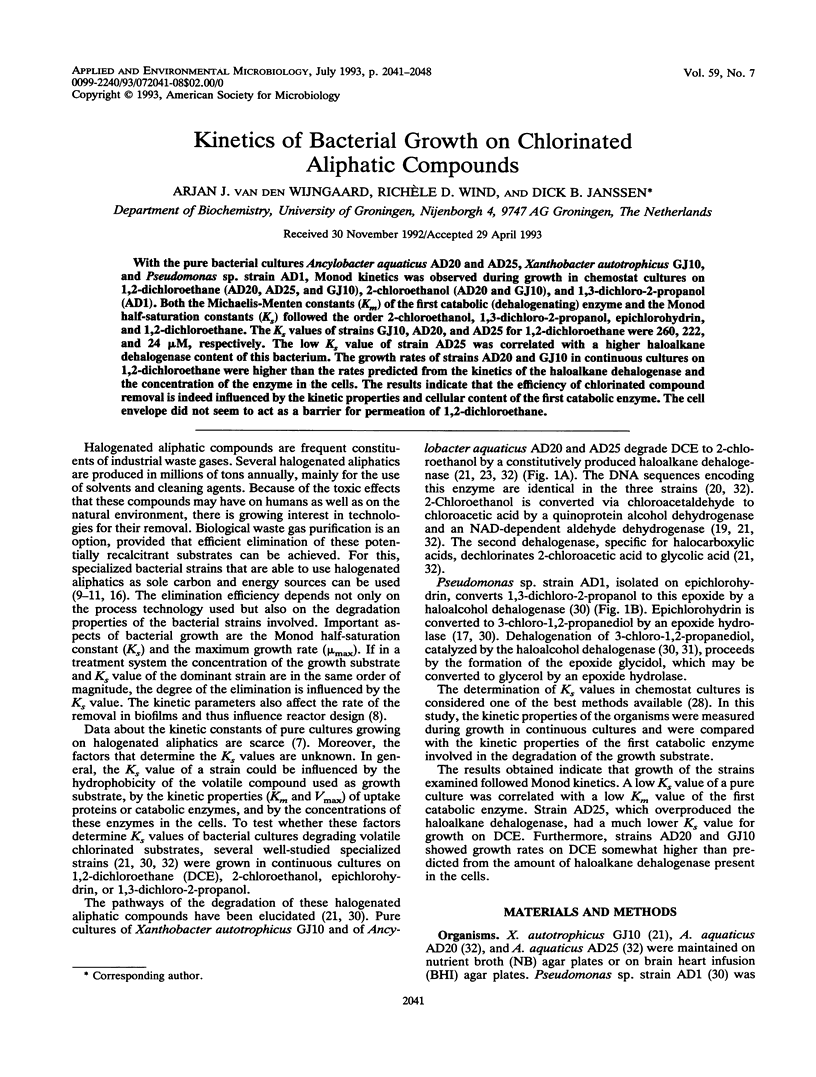

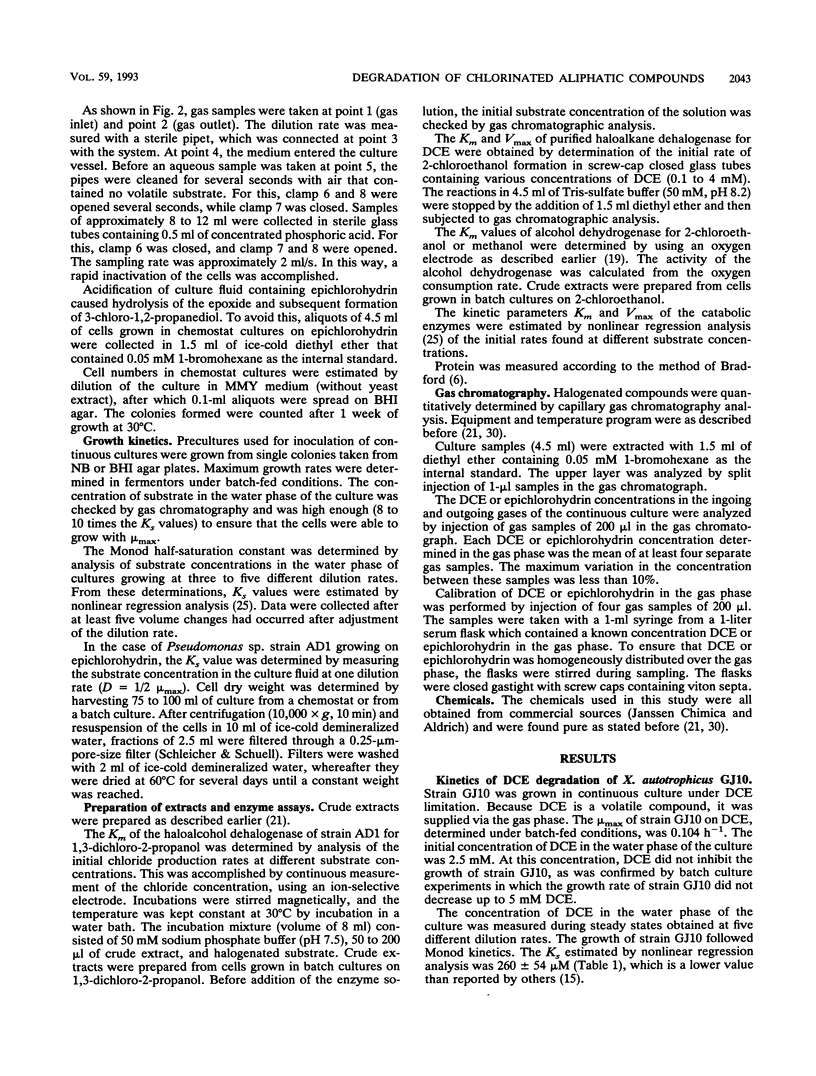
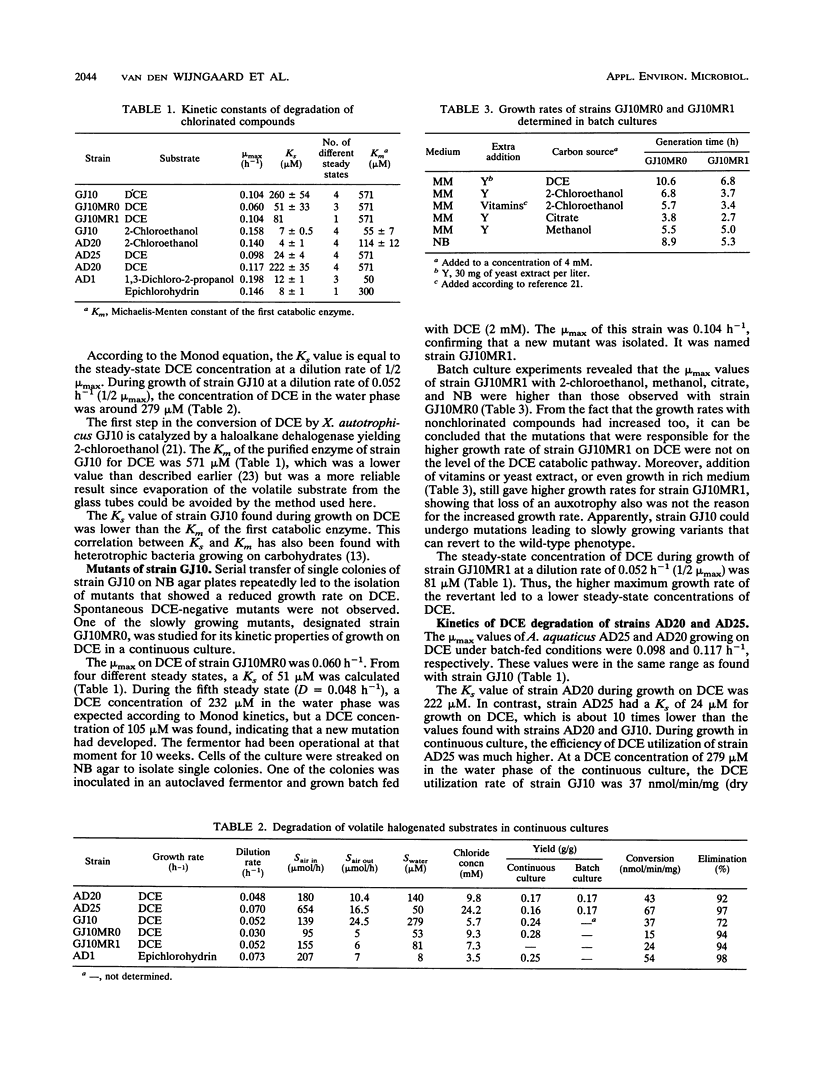
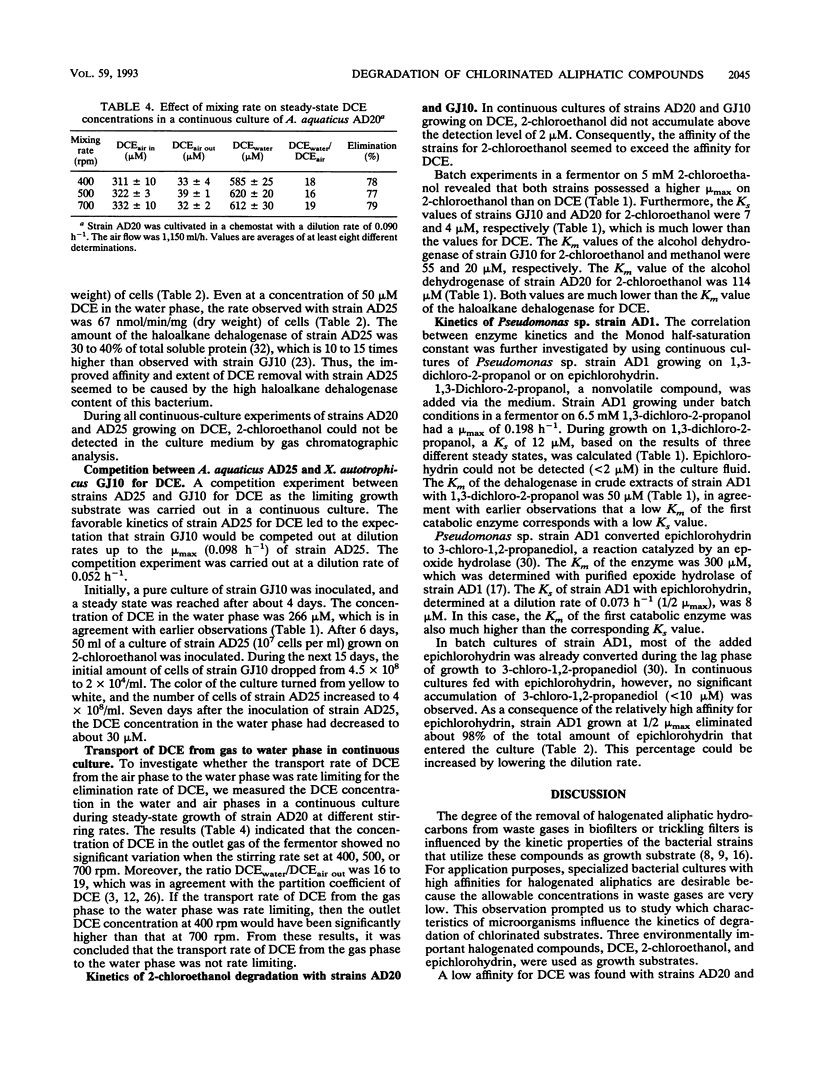
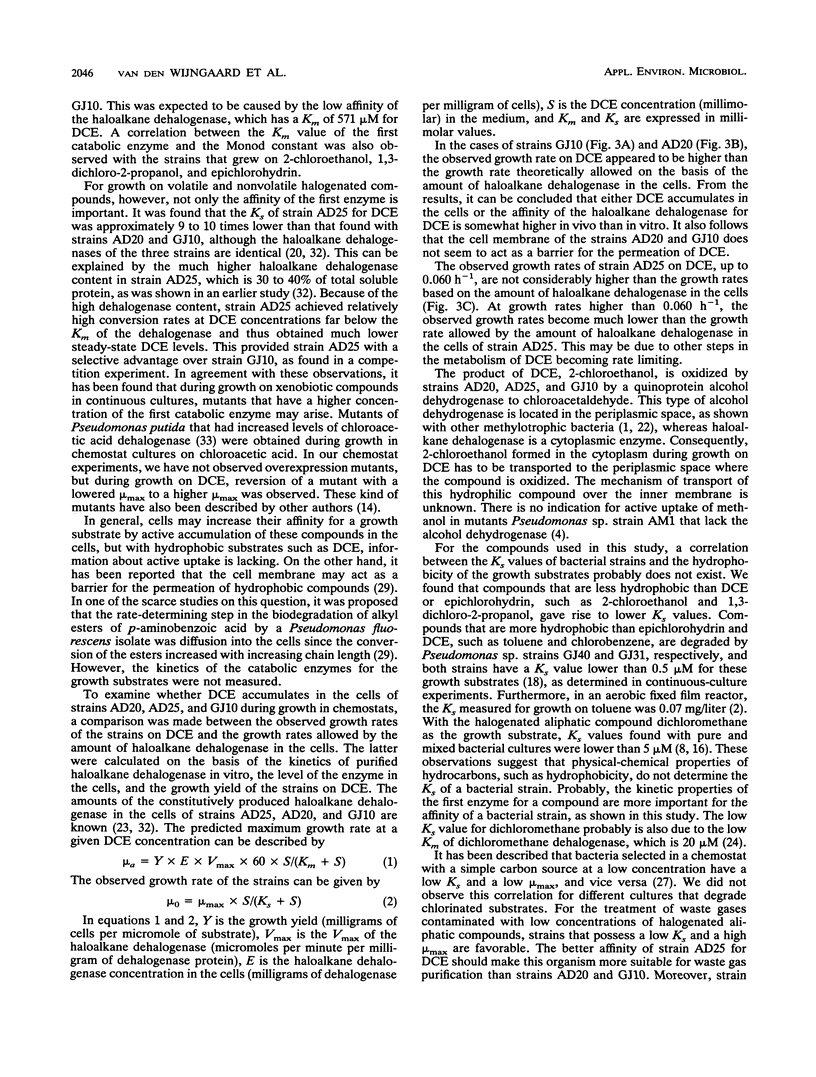

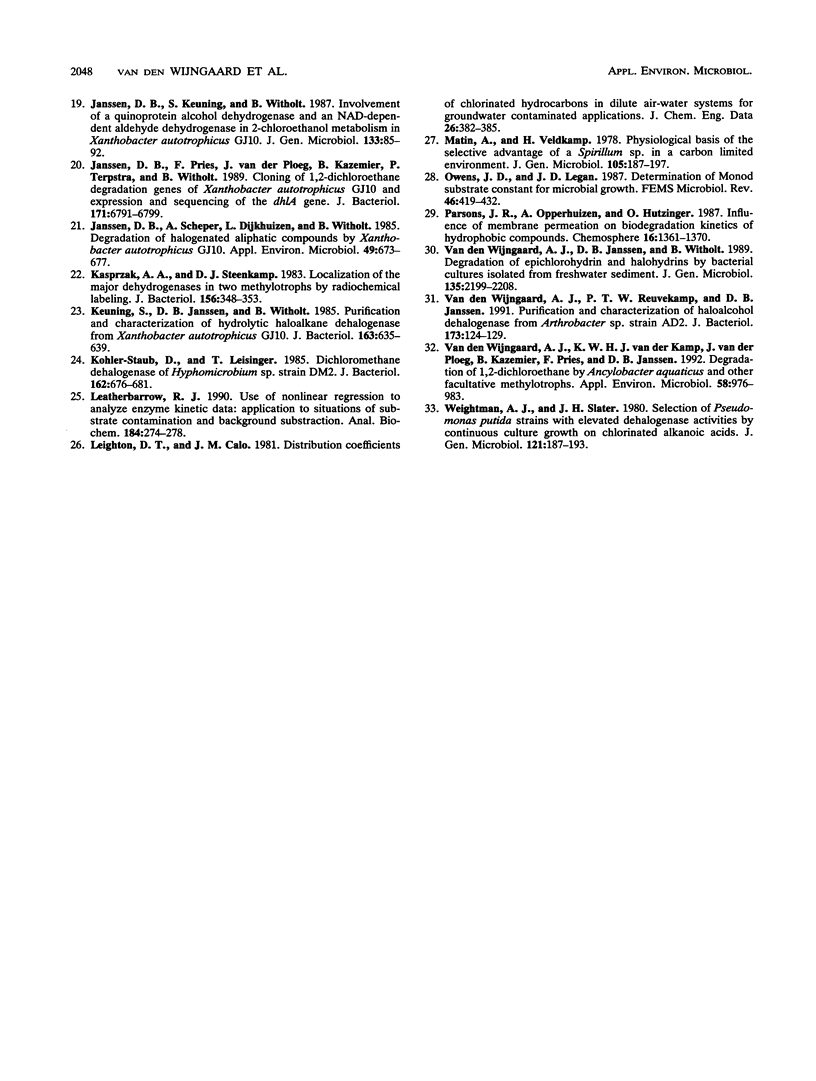
Selected References
These references are in PubMed. This may not be the complete list of references from this article.
- Alefounder P. R., Ferguson S. J. A periplasmic location for methanol dehydrogenase from Paracoccus denitrificans: implications for proton pumping by cytochrome aa3. Biochem Biophys Res Commun. 1981 Feb 12;98(3):778–784. doi: 10.1016/0006-291x(81)91179-7. [DOI] [PubMed] [Google Scholar]
- Bellion E., Kent M. E., Aud J. C., Alikhan M. Y., Bolbot J. A. Uptake of methylamine and methanol by Pseudomonas sp. strain AM1. J Bacteriol. 1983 Jun;154(3):1168–1173. doi: 10.1128/jb.154.3.1168-1173.1983. [DOI] [PMC free article] [PubMed] [Google Scholar]
- Bradford M. M. A rapid and sensitive method for the quantitation of microgram quantities of protein utilizing the principle of protein-dye binding. Anal Biochem. 1976 May 7;72:248–254. doi: 10.1016/0003-2697(76)90527-3. [DOI] [PubMed] [Google Scholar]
- Button D. K. Kinetics of nutrient-limited transport and microbial growth. Microbiol Rev. 1985 Sep;49(3):270–297. doi: 10.1128/mr.49.3.270-297.1985. [DOI] [PMC free article] [PubMed] [Google Scholar]
- Harder W., Dijkhuizen L. Physiological responses to nutrient limitation. Annu Rev Microbiol. 1983;37:1–23. doi: 10.1146/annurev.mi.37.100183.000245. [DOI] [PubMed] [Google Scholar]
- Harder W., Kuenen J. G. A review. Microbial selection in continuous culture. J Appl Bacteriol. 1977 Aug;43(1):1–24. doi: 10.1111/j.1365-2672.1977.tb00717.x. [DOI] [PubMed] [Google Scholar]
- Jacobs M. H., Van den Wijngaard A. J., Pentenga M., Janssen D. B. Characterization of the epoxide hydrolase from an epichlorohydrin-degrading Pseudomonas sp. Eur J Biochem. 1991 Dec 18;202(3):1217–1222. doi: 10.1111/j.1432-1033.1991.tb16493.x. [DOI] [PubMed] [Google Scholar]
- Janssen D. B., Pries F., van der Ploeg J., Kazemier B., Terpstra P., Witholt B. Cloning of 1,2-dichloroethane degradation genes of Xanthobacter autotrophicus GJ10 and expression and sequencing of the dhlA gene. J Bacteriol. 1989 Dec;171(12):6791–6799. doi: 10.1128/jb.171.12.6791-6799.1989. [DOI] [PMC free article] [PubMed] [Google Scholar]
- Janssen D. B., Scheper A., Dijkhuizen L., Witholt B. Degradation of halogenated aliphatic compounds by Xanthobacter autotrophicus GJ10. Appl Environ Microbiol. 1985 Mar;49(3):673–677. doi: 10.1128/aem.49.3.673-677.1985. [DOI] [PMC free article] [PubMed] [Google Scholar]
- Kasprzak A. A., Steenkamp D. J. Localization of the major dehydrogenases in two methylotrophs by radiochemical labeling. J Bacteriol. 1983 Oct;156(1):348–353. doi: 10.1128/jb.156.1.348-353.1983. [DOI] [PMC free article] [PubMed] [Google Scholar]
- Keuning S., Janssen D. B., Witholt B. Purification and characterization of hydrolytic haloalkane dehalogenase from Xanthobacter autotrophicus GJ10. J Bacteriol. 1985 Aug;163(2):635–639. doi: 10.1128/jb.163.2.635-639.1985. [DOI] [PMC free article] [PubMed] [Google Scholar]
- Kohler-Staub D., Leisinger T. Dichloromethane dehalogenase of Hyphomicrobium sp. strain DM2. J Bacteriol. 1985 May;162(2):676–681. doi: 10.1128/jb.162.2.676-681.1985. [DOI] [PMC free article] [PubMed] [Google Scholar]
- Leatherbarrow R. J. Use of nonlinear regression to analyze enzyme kinetic data: application to situations of substrate contamination and background subtraction. Anal Biochem. 1990 Feb 1;184(2):274–278. doi: 10.1016/0003-2697(90)90680-8. [DOI] [PubMed] [Google Scholar]
- Matin A., Veldkamp H. Physiological basis of the selective advantage of a Spirillum sp. in a carbon-limited environment. J Gen Microbiol. 1978 Apr;105(2):187–197. doi: 10.1099/00221287-105-2-187. [DOI] [PubMed] [Google Scholar]
- van den Wijngaard A. J., Reuvekamp P. T., Janssen D. B. Purification and characterization of haloalcohol dehalogenase from Arthrobacter sp. strain AD2. J Bacteriol. 1991 Jan;173(1):124–129. doi: 10.1128/jb.173.1.124-129.1991. [DOI] [PMC free article] [PubMed] [Google Scholar]
- van den Wijngaard A. J., van der Kamp K. W., van der Ploeg J., Pries F., Kazemier B., Janssen D. B. Degradation of 1,2-dichloroethane by Ancylobacter aquaticus and other facultative methylotrophs. Appl Environ Microbiol. 1992 Mar;58(3):976–983. doi: 10.1128/aem.58.3.976-983.1992. [DOI] [PMC free article] [PubMed] [Google Scholar]


